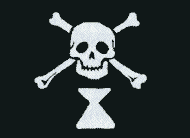In general, pirates did not create any new weapons. They simply used weapons that were in common use at the time. Still, there are differences between what pirates used and how they used them and how weapons were used in general in the GAoP (Golden age of Piracy).
A pirate's favorite weapon was the pistol. This is the biggest difference between them and the rest of the population. Pistols were normally used by civilians and officers. Regular soldiers were not issued pistols.
A pistol is generally a short-range weapon. Black powder expands slowly and a long barrel is needed in order to give the powder enough time to accelerate a ball to maximum speed. The shorter barrel means that the ball will be traveling substantially slower. In addition, pistols usually shot smaller balls than a musket. This means that a pistol ball will fall short before a musket ball does and that a pistol ball does not have the penetrating power of a musket ball.
There are other problems with pistols. Firing one-handed is not as accurate as firing a gun resting on the shoulder and steadied with both hands. A musket is carried muzzle-up while a pistol is usually carried muzzle-down. This means that a musket ball does not need to be tight-fitting which, in turn, speeds up loading. If a pistol is loaded with a loose-fitting ball and stuffed in a sash, the ball will fall out. A tight-fitting ball takes longer to load since it has to be forced down the barrel.
So why would pirates prefer a pistol? It has to do with the types of fights they had.
Ships are small. Even the largest ship of the time measured from stem to stern was barely as long as standard battlefield distances. If you are fighting on a ship you are going to be close enough that the problems with range and penetrating power do not matter. The same is true with aiming. You shoot at someone who is directly in front of you. The chance that you will actually hit him is higher than the odds of hitting someone at standard musket distances.
Pirates had a simple solution for the slow reloading time. They carried multiple pistols.
Muskets on the other hand, are difficult to use in close-quarter combat; you cannot carry more than one at a time; and loading them in a melee or on a small boat is difficult. Which doesn't mean that muskets were not used, just that they were confined to ship-to-ship fighting or land-invasion.
The infamous blunderbuss is another weapon that was mainly used by civilians and pirates. It is basically a sawed-off shotgun and is most effective against a group at close range.
The carbine is probably under-represented among pirate reenactors. This is a shortened musket. It was mainly used by cavalry and could be carried on a shoulder sling. There was also a naval version. The carbine had a greater range and penetrating power than a pistol and could be loaded faster than a pistol or musket but the short barrel made it easier to use in a crowd or on a small boat. If it was carried on a sling then it would need a tight-fitting ball.
Cannons are another example of a weapon being used differently. Unlike most naval battles, pirates seldom wanted to sink the ship that they were attacking nor did they want to cause too much damage if it was a ship that they might want to take as a prize. That limited their choices in ammunition. The best choices for pirates would be canister shot or grape shot. This was a load of musket balls which turned a cannon into a huge, powerful shotgun capable of decimating a crew but sparing the ship. Bar shot and chain shot might also be used. These were effective anti-personnel loads but they could also be used to disable a ship's sails, rigging, and masts.
Swords are a special case. Through the middle of the 17th century, some troops were issued swords and some were not. Officers and cavalry always had them. Pikemen (pikes are 16-20 foot-long spears) often had them. Musketeers usually did not carry swords. It is difficult to use a sword while carrying a musket so musketeers depended on the pikemen for protection from hand-to-hand combat or used their muskets as clubs.
At sea, hand to hand combat is the norm rather than the exception so most people had a sword or alternate cutting implement such as a boarding ax.
Finally, grenades were known but seldom used on the battlefield for the simple reason that it was hard to pitch one into the right place at the right time. Again, given the closer quarters of a fight on a ship, a grenade could be more easily used.
Subscribe to:
Post Comments (Atom)


No comments:
Post a Comment